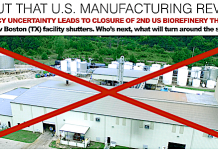Jim Lane
A now-complete 142 million gallon green diesel monster project will easily deliver big on renewable energy targets and greenhouse gas emissions reduction.
But it also offers a material path to profits for its parents, Valero Energy and Darling International.
In Louisiana, Darling International (DAR) announced that Diamond Green Diesel, the joint venture between Valero (VLO) subsidiary Diamond Alternative Energy LLC and Darling International , has reached mechanical completion and the startup process will lead to full production of renewable diesel.
Once in full operations, the 9,300 barrel-per-day (142.5 million gallon) plant in Norco, Louisiana will process recycled animal fat and used cooking oil as well as corn oil into renewable diesel fuel that has comparable properties to petroleum-based diesel. The renewable diesel can be shipped by pipeline and meets low-carbon fuel standards.
![diamond-green-diesel[1].png](http://www.altenergystocks.com/wp-content/uploads/2017/08/diamond_green_diesel_1_.png) |
| The Diamond Green Diesel plant in Norco, during construction. |
According to company estimates, the facility will reduce greenhouse gases by more than 80 percent over conventional petroleum-based diesel; fulfill almost 14 percent of a national mandate to boost production for biomass-based diesel; and create more than 700 jobs at peak construction in Louisiana.
The plant features Honeywell (HON) UOP’s Ecofining pretreatment and hydrotreating/isomerization process to convert animal-based oils into hydrocarbon fuels similar but not exactly the same as the hydrotreating processes used by Dynamic Fuels (also in Louisiana) as well at Neste Oil’s massive plants in Singapore, the Netherlands and Finland.
The project will sell diesel into the market on an unsubsidized basis, at the rack price supplementing its bottom line with the value of renewable energy RINs that are used by obligated parties to satisfy their obligations under the Renewable Fuel Standard.
Darling International Chairman and Chief Executive Officer Randall Stuewe said, “We are proud to report the mechanical completion and startup of Diamond Green Diesel. This joint venture will be a producer of high quality renewable diesel capable of fulfilling the RFS2 biomass-based diesel mandate. Our partnership with Valero will benefit Diamond Green Diesel through multiple operational synergies.”
Renewable diesel – 3 reasons it really, really matters.
As we wrote in “Renewable Diesel Surges” last year:
1. It’s a drop-in biofuel, requiring no infrastructure change – and there are generally no limits on its distribution except those imposed by cost and geography, and the size of the global diesel pool itself, which could absorb capacity from hundreds of advanced biofuels projects.
2. It’s renewable, here now, made at home, and at-scale today. No need to wait for the promise of algal biofuels, or other hot technologies still in the process of commercializing at scale. More than 600 million gallons of capacity already exists – Dynamic Fuels plant in Louisiana, and three from Neste Oil (NEF.F) in Rotterdam, Singapore and Finland.
3. In the case of Dynamic Fuels, Diamond Green and Emerald Biofuels, all three projects can utilize animal waste residues – a classic case of turning low-value, noxious feedstocks into high-value molecules.
Existing feedstocks rule, scale matters
To work as a financial project, Diamond Green Diesel will be the largest consumer of recycled restaurant grease and animal fats in North America (1.1 billion pounds annually). As much as 11% of US used cooking oils and animal fats will be processed at the Diamond Green Diesel facility
As we wrote in naming this project to our “Diamond Dozen“:
“Overwhelmingly, one trend is clear: all of the projects expected to reach significant scale by 2017 features a feedstock that is already aggregated, or already in existence and easy to aggregate. Novel feedstocks such as energy grasses or canes – that’s a sure ticket to small-scale or the very long term.
“Take the existing US corn ethanol fleet, for example. Three companies are expected to build 1.2 billion gallons of advanced biofuels (Butamax, Gevo (GEVO) and POET-DSM) over the next five years using corn starch, cobs and stover. Then there’s the existent wood basket – which forestry companies have long since demonstrated an ability to grow, harvest and aggregate on a sustainable basis.
“Animal residues and palm oil (already aggregated) represent another 709 million gallons, and then we have more than 600 million gallons from natural gas. Even the advanced fermentation technologies expect to use existing supplies of sugars and CO2.
“The message is clear. The bottleneck in advanced biofuels – the underlying problem in the “Where are the gallons?” equation – lies in the feedstocks. There are. these days, plenty of technologies available that can generate 70-130 gallons per ton of biomass at what, according to their analysis, will be at competitive prices to $100 oil.
RINs matter
In December, Dynamic Fuels filed this with the SEC:
“The economics of the U.S. biomass based diesel industry are currently challenged by significantly lower RIN (renewable identification number) prices. D4 RIN prices averaged $1.39 for the first six months of 2012. As of December 10, 2012, the D4 RIN price was $0.56. RIN prices at these levels have not been seen since the implementation of the RFS2 program by EPA in July of 2010.
“The regulatory framework underpinning biomass based diesel production remains intact. The biomass based diesel mandate for 2013 is 1.28 billion gallons, or 28% above the 2012 mandate. We expect markets to adjust positively in 2013 due to the higher mandate.”
The Economics
In a presentation that Darling made to shareholders and analysts, the company went through the economics of its fuel pro-forma, showing a projected $1.03 in profit per gallon. Note that this is based on operating costs only.
However, the good news is that, on a dollars per gallon of capacity basis, the project is not all that expensive by advanced biofuels standards. Valero projected the cost in 2011 to be $368 million which works out to be $2.59 per gallon of capacity, or $0.17 per gallon per year if amortized over 15 years (excluding interest costs, because in this case Valero financed the plant without tapping a $241 million DOE loan guarantee.
Items to watch in those profit projections diesel prices and RIN prices. Gulf Coast ULS diesel is selling at $2.82 this week, down from the $3.07 projection in the Darling forecast. Meanwhile, as Dynamic Fuels indicated, RIN prices were in the $0.56 range in December, though they h
ave subsequently climbed back to more than $0.80 in the past quarter.
One more item – feedstock costs. $0.44 per pound for blended fat. Man, is that price getting high for waste fats.
The Bottom Line
A signature mechanical completion. We hope the commissioning period is short enough that the plant may start making a material contribution to US biobased diesel production figures in the 4th quarter.
But this much is sure. It’s not only transformative fuel with emissions in the 80% reduction range but it’s profitable fuel, sold on an unsubsidized basis (no tax credits) although greatly assisted by the economics within the Renewable Fuel Standard. It’s expected to become a material contributor to Darling’s bottom line and if profits continue to be available, will do much to persuade Valero amongst others of the benefits of continuing to invest in renewable fuels.
Disclosure: None.
Jim Lane is editor and publisher of Biofuels Digest where this article was originally published. Biofuels Digest is the most widely read Biofuels daily read by 14,000+ organizations. Subscribe here.







